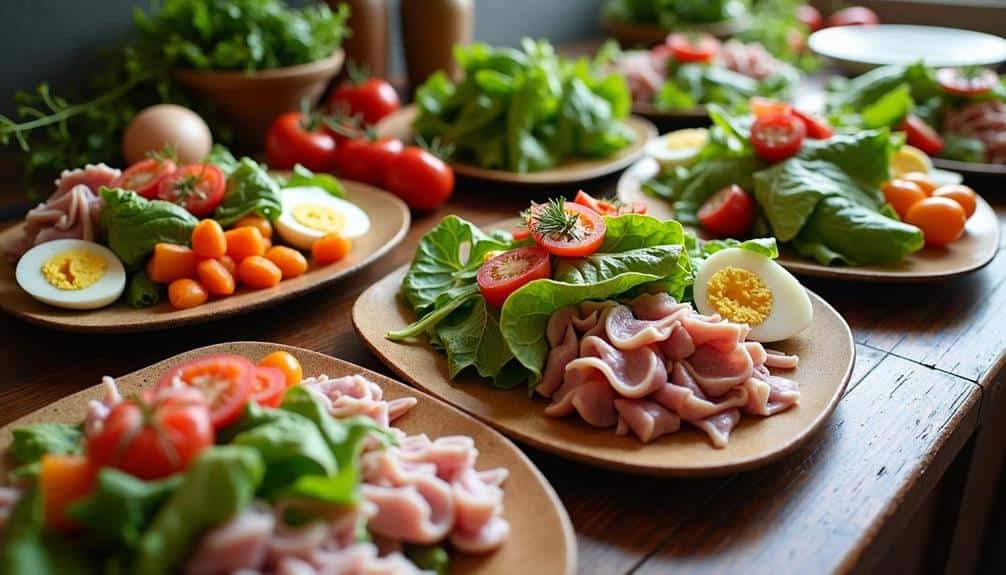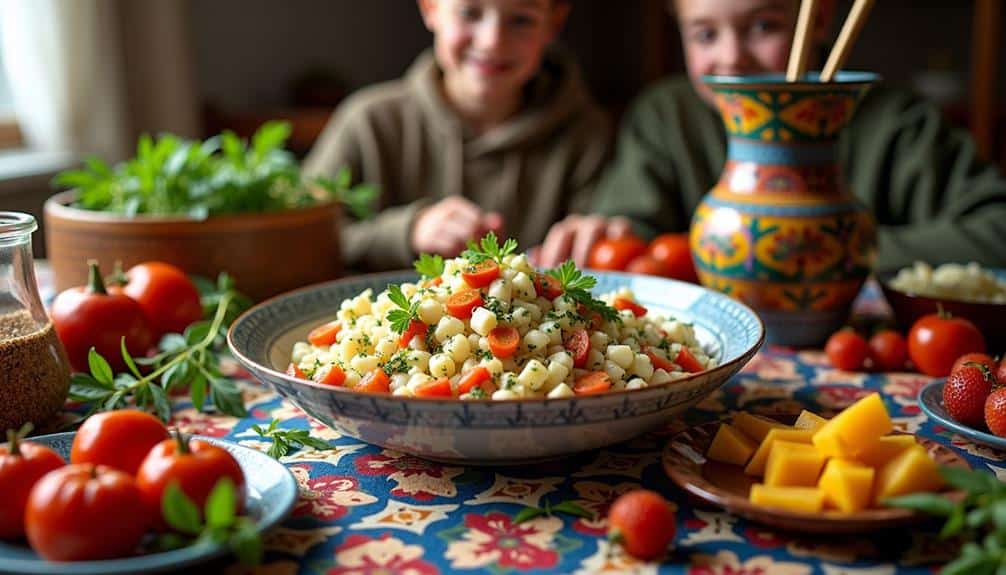When you think about Russian cuisine, Olivier Salad might not be the first dish that comes to mind, but its history is as rich as its creamy dressing. Originating in the 19th century and crafted by Belgian chef Lucien Olivier, this salad initially dazzled Moscow’s elite with its luxurious ingredients. Over time, it morphed into a staple of Soviet-era festivity, reflecting profound socio-political shifts. But how did a dish once reserved for the upper echelon become a symbol of Russian cultural identity, still cherished during modern New Year’s celebrations? Let’s explore this fascinating culinary journey.
Origins of Olivier Salad

The origins of Olivier Salad are deeply rooted in 19th-century Russian culinary history. You’ll find that this dish, commonly known as Russian Salad, showcases a fascinating blend of French cuisine and Russian adaptation. During this period, French chefs were highly sought after by the Russian aristocracy, and their influence permeated the upper echelons of Russian society. The salad itself is a reflection of this cultural exchange.
When you examine the ingredients traditionally used in Olivier Salad, you’ll notice the incorporation of luxurious and diverse elements. Classic French culinary techniques are evident in the use of high-quality meats, rich dressings, and intricate preparation methods.
However, as the salad grew in popularity, it adapted to local tastes and available ingredients, becoming more accessible to the general population. This Russian adaptation is key to understanding the salad’s evolution.
Over time, ingredients like caviar and capers were substituted with more common items such as peas, potatoes, and carrots, making it a versatile dish suited for various occasions. The melding of French finesse with Russian pragmatism encapsulates the unique cultural fusion that defines Olivier Salad, making it a beloved staple in Russian cuisine.
Lucien Olivier’s Influence
During the mid-19th century, Lucien Olivier, a Belgian chef, played a pivotal role in shaping what we now recognize as Olivier Salad. His culinary innovation left an indelible mark on Russian cuisine.
At the Hermitage, a renowned Moscow restaurant, Olivier crafted a dish that was both complex and lavish, reflecting his sophisticated European training. His salad combined a variety of ingredients, including game meats, caviar, and a secret sauce, which set it apart from any other dish of the time.
Olivier’s legacy in the culinary world can’t be overstated. Through his inventive approach, he introduced a blend of flavors and textures that were previously unseen in Russian gastronomy.
His meticulous attention to detail and commitment to quality elevated the salad to a symbol of luxury and elegance. You can see how his creation not only gained popularity among the Russian elite but also set a standard for fine dining.
Evolution of the Recipe

Often evolving through the decades, the recipe for Olivier Salad has undergone significant transformations since Lucien Olivier first introduced it.
Initially a luxurious dish, the original recipe included rare and expensive ingredients such as caviar, grouse, and crayfish tails. However, as the salad became more accessible, cooks started using more common ingredients.
You’ll notice that the modern version typically features boiled potatoes, carrots, peas, pickles, and boiled eggs, mixed with boiled chicken or bologna, and dressed with mayonnaise.
These ingredient variations reflect a shift toward simplicity and practicality, aligning with the broader availability of these items in Soviet and post-Soviet eras.
Olivier Salad Ingredients:
– 4 potatoes
– 4-5 pickles
– 1 cup cooked ham, diced
– 1/2 cup canned green peas
– 2 carrots
– 4 hard-boiled eggs
– 1 cup mayonnaise
– Salt and pepper, to taste
Preparation:
1. Boil potatoes and carrots until tender. Let them cool, then peel and dice.
2. Dice pickles and hard-boiled eggs, discarding the yolks.
3. In a large bowl, combine potatoes, carrots, pickles, diced ham, green peas, and eggs.
4. Season with salt and pepper, then add mayonnaise. Mix well.
5. Refrigerate for a few hours to blend flavors before serving. Enjoy cold.
Olivier Salad has also become a staple on festive occasions, especially during New Year’s celebrations in Russia.
Its adaptability allows you to customize the recipe to suit your taste or the season, making it a versatile dish.
Ingredient substitutions, such as using ham instead of chicken or adding apples for a touch of sweetness, are common.
Socio-Political Impact
Amidst its culinary journey, Olivier Salad didn’t just evolve in taste but also mirrored the socio-political landscape of its time. When it first emerged in the 1860s, Russia was still under Tsarist rule. The lavish ingredients of the original recipe reflected the opulence of the Russian elite.
However, as socio-political changes swept across Russia, so too did the salad’s composition. The Soviet era, marked by resource scarcity and egalitarian ideals, transformed Olivier Salad into a more accessible dish, using simpler, locally available ingredients.
You’ll notice that Olivier Salad also played a role in culinary diplomacy. During the Cold War, it became a staple at state banquets and international gatherings, symbolizing Soviet hospitality. The salad’s adaptability allowed it to transcend socio-political barriers, becoming a shared cultural artifact in various countries influenced by Soviet policies.
Therefore, Olivier Salad’s evolution wasn’t just about ingredients but also about reflecting and adapting to the socio-political context. By understanding these dynamics, you gain deeper insight into how a seemingly simple dish can encapsulate significant historical and political narratives, making it a culinary lens through which to view Russia’s complex history.
Cultural Significance Today

As you examine Olivier Salad’s socio-political journey, it becomes evident that its cultural significance today is equally compelling. This dish, once a symbol of opulence, has evolved into a staple of Russian cuisine, particularly during festive occasions.
Whether it’s New Year’s Eve, Christmas, or a family gathering, Olivier Salad holds a cherished place on dining tables, embodying a sense of tradition and communal celebration.
Modern variations of the salad reflect both global influences and local preferences. While the classic ingredients—boiled potatoes, carrots, peas, eggs, pickles, and mayonnaise—remain, contemporary twists often include exotic additions like seafood, different meats, or even vegetarian alternatives.
These adaptations demonstrate the dish’s versatility and its ability to evolve with changing tastes and dietary needs.
Moreover, its preparation and consumption foster a sense of nostalgia and cultural continuity. Each family might’ve its own recipe, passed down through generations, contributing to a shared yet personalized culinary heritage.
In today’s fast-paced world, Olivier Salad serves as a comforting link to the past, while its modern variations guarantee its relevance. Consequently, Olivier Salad continues to be a potent symbol of Russian cultural identity.
Conclusion
You’ve seen how Olivier Salad has evolved from a luxurious dish crafted by Lucien Olivier to a festive staple reflecting Russia’s socio-political changes. This salad isn’t just a recipe; it’s a cultural artifact that embodies Russian history and identity. Today, it serves as both a nostalgic reminder of the past and a canvas for modern culinary adaptations. By understanding its journey, you appreciate not just a dish, but a significant piece of Russian heritage.




